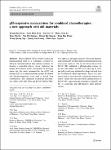Item Infomation
Full metadata record
| DC Field | Value | Language |
|---|---|---|
| dc.contributor.advisor | Tuan Hiep Tran | - |
| dc.contributor.advisor | Yen Hai Vu | - |
| dc.contributor.advisor | Thien Giap Le | - |
| dc.contributor.advisor | Thao Thi Do | - |
| dc.contributor.advisor | Nga Thi Nguyen | - |
| dc.contributor.advisor | Thuan Thi Nguyen | - |
| dc.contributor.advisor | Tung Bao Pham | - |
| dc.contributor.advisor | Trung Quang Ngo | - |
| dc.contributor.advisor | Quang Anh Luong | - |
| dc.contributor.advisor | Chien Ngoc Nguyen | - |
| dc.contributor.author | Trong Bien Tran | - |
| dc.date.accessioned | 2021-07-06T03:16:27Z | - |
| dc.date.available | 2021-07-06T03:16:27Z | - |
| dc.date.issued | 2021 | - |
| dc.identifier.uri | https://link.springer.com/article/10.1007%2Fs10570-021-03769-y | - |
| dc.identifier.uri | https://dlib.phenikaa-uni.edu.vn/handle/PNK/1960 | - |
| dc.description | Q1 | vi |
| dc.description.abstract | Ethyl cellulose (EC) is widely used in the pharmaceutical field as a polymeric excipient to fabricate sustained-release drug delivery systems. To develop a controlled release carrier exploiting the unique characteristic acidic environment of the target tumor site, this study examined the use of EC and lecithin (LC) as a nanoparticulated system. Paclitaxel and dihydroartemisinin were used as model drug combinations. The optimized formulated nanoparticles (NPs) of EC (EC NPs) and EC/LC (EC/LC NPs) were spherical and approximately 130 nm in diameter as determined by dynamic light scattering and electron microscopy analyses. The in vitro drug release from EC/LC NPs exhibited a pH-dependent pattern. In in vitro cell studies, the NPs were taken up by cells, and cell growth was inhibited by drugs released from the formulations. Most importantly, the in vivo anti-tumor study in mice showed a significant reduction in tumor volume after the intravenous administration of EC/LC NPs, suggesting the potential of using EC and LC as controlled and pH-sensitive drug delivery carriers. | vi |
| dc.language.iso | en | vi |
| dc.publisher | Cellulose | vi |
| dc.subject | Combination therapy | vi |
| dc.subject | Ethyl cellulose | vi |
| dc.subject | pH-responsive | vi |
| dc.subject | pH-responsive | vi |
| dc.title | pH-responsive nanocarriers for combined chemotherapies: a new approach with old materials | vi |
| dc.type | Article | vi |
| eperson.identifier.doi | https://doi.org/10.1007/s10570-021-03769-y | - |
| Appears in Collections | ||
| Bài báo khoa học | ||
Files in This Item:

